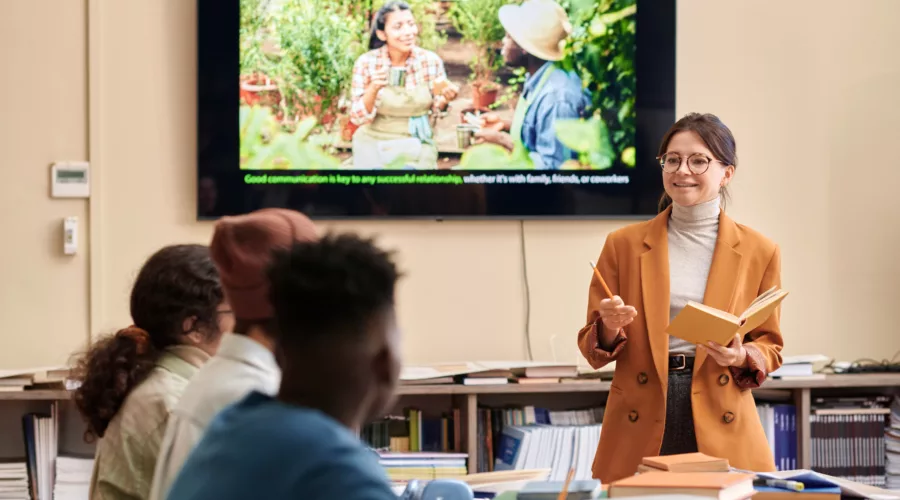Is EdTech Replacing Group Study in Today’s Digital Education System?
The question of whether EdTech is replacing Group Study or not will continue to be debated for a long time, but it’s evident that group study has always played a crucial role in students’ academic success. By learning together, students share ideas, clarify concepts, and reinforce their understanding in a more relaxed, engaging environment. But in an age where digital evolution is reshaping how we learn, EdTech tools like SchoolTry are becoming central to school systems.
These platforms streamline academic processes, support learning, and raise questions about how group study, as we know it, is changing. Is EdTech replacing group study—or simply evolving it? Let’s dive in.
What is Group Study?
Group study is more than students sitting together to read; it’s an active learning method that improves retention, encourages critical thinking, and fosters communication skills. After lectures, assignments, and school activities, students often find it helpful to reflect on what they’ve learned, and doing this collectively enhances understanding.
In group settings, students hear multiple perspectives, tackle problems together, and boost each other’s confidence. It also cultivates a sense of accountability and motivation, especially when preparing for exams or completing tough assignments.
Group study breaks the rigidity of formal learning environments and provides a social, engaging alternative where students learn by teaching one another. This method has been proven to help students better absorb knowledge, make connections across topics, and stay emotionally supported during academic stress.

What is EdTech and Why is it Changing the Face of Education?
Educational Technology (EdTech) refers to the integration of technology into teaching and learning processes. It includes digital tools, software, and applications that aim to make education more efficient, accessible, and interactive. From platforms like SchoolTry, which help manage student records, assignments, and communication, to apps that offer self-paced courses and AI-powered tutors, EdTech is redefining the classroom experience.
In today’s digital-first world, students are no longer limited to physical textbooks and whiteboards. They now explore knowledge through YouTube videos, podcasts, gamified apps, and real-time collaboration tools. This evolution has allowed learning to become self-directed, remote, and highly customizable. More importantly, it prepares students for the digital reality they will face beyond the classroom.
Will EdTech Replace Group Study or Reinvent It?
With the rise of EdTech, many wonder if digital platforms are isolating students from traditional peer-based learning. But rather than replace group study, EdTech is transforming it into something more dynamic and inclusive. Students aren’t just reading alone behind screens; they are engaging in virtual discussions, forming study groups via apps, and collaborating with peers across distances.
The nature of group study has shifted from round-table discussions in classrooms to digital forums, group chats, shared document editing, and live virtual sessions. These methods allow more flexibility and broader participation, especially for students who are introverted, remote, or prefer self-paced interactions.
How EdTech is Revolutionizing Group Study in the Digital Age
1. Online Collaboration:
Thanks to EdTech, students can now collaborate regardless of physical location. Tools like Google Docs, Zoom, Slack, and Microsoft Teams and integrated systems like SchoolTry enable students to co-study, brainstorm, and edit assignments in real time. Online discussion boards and group chats make it easy for students to ask questions, explain ideas, and crowdsource solutions.
Moreover, students now connect with peers from other schools, countries, or cultural backgrounds, broadening their learning exposure. This global approach to group study helps students gain new insights, develop cultural intelligence, and sharpen their communication skills.
2. Virtual Study Groups:
Today’s students are digital natives who organize their learning communities online. Whether it’s a WhatsApp group, Discord server, or a private school platform like SchoolTry, students are building virtual hubs where learning thrives. These groups allow them to revise past papers, share voice notes, post quiz links, and even host mock exams remotely.
Virtual study groups remove the barriers of time, location, and rigid schedules, making group study more accessible than ever. Students can now participate in group discussions from the comfort of their homes, during commutes, or late at night whenever they feel most productive.
3. Real-Time Resource Sharing:
Another major advantage EdTech brings to group study is the ease of real-time resource sharing. Instead of printing notes or waiting to meet up, students now share files, screenshots, audio notes, and links instantly. This enhances the quality of study materials, speeds up comprehension, and fosters a culture of collective intelligence.
Platforms like SchoolTry also support resource uploads and class discussions, enabling teachers and students to create centralized digital libraries of learning content. This reduces information gaps and ensures every group member stays informed and engaged.
Benefits of Using EdTech in Group Study
1. Flexible Learning:
In today’s fast-paced world, students want learning that adapts to their schedule and lifestyle. EdTech makes this possible by allowing students to study anytime, anywhere. They can revisit recorded lessons, access group discussions, and catch up on missed content without missing a beat—all while staying connected with peers.
2. Effective Communication:
With integrated chat features, live video tools, and shared digital workspaces, EdTech platforms foster consistent and instant communication among students. Whether discussing assignments or prepping for exams, group members stay engaged and aligned throughout the learning process.
3. Inclusive Collaboration:
EdTech supports diverse learning styles by giving every student a voice. From interactive boards to peer-to-peer discussion threads, it creates a space where students comfortably exchange ideas, ask questions, and collaborate meaningfully no matter their learning pace or personality.
4. Digital Skills & Academic Growth:
While engaging in group study through EdTech, students naturally build digital skills that boost their academic and career growth. Navigating online platforms, managing virtual projects, and collaborating digitally help them stay prepared for the future.
5. Efficient Assessments:
EdTech platforms offer interactive tools like real-time quizzes, flashcards, and collaborative documents that make study sessions more efficient. Students can co-create content, track progress, and get feedback—all within one ecosystem, making learning faster and more organized.
Conclusion
Rather than replacing traditional group study, EdTech has evolved it into something more powerful, inclusive, and efficient. Platforms like SchoolTry not only simplify academic management but also support collaborative learning by enabling students to connect, share, and grow together.
As technology continues to shape the educational landscape, students will benefit most when they embrace both the collaborative spirit of group study and the innovative tools of EdTech. Together, these elements can create a learning environment where everyone succeeds.
Are you a school administrator in need of a web solution like SchoolTry to automate, digitise, or transform your schoolwork? Register for free here and see how it works.




